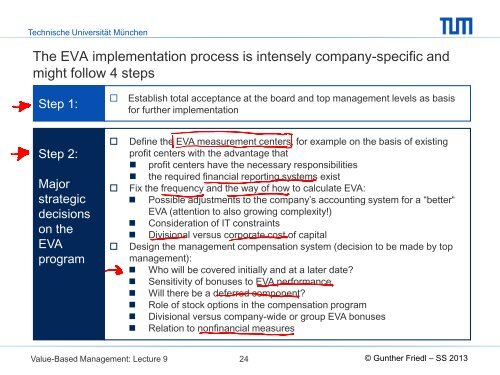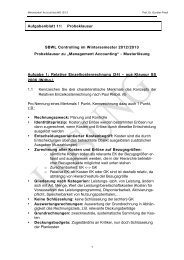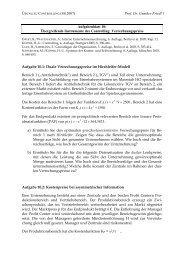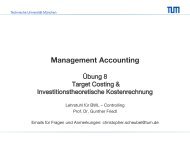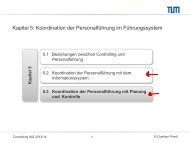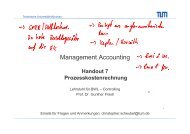Lecture 9 - Lehrstuhl für Controlling - Technische Universität München
Lecture 9 - Lehrstuhl für Controlling - Technische Universität München
Lecture 9 - Lehrstuhl für Controlling - Technische Universität München
Create successful ePaper yourself
Turn your PDF publications into a flip-book with our unique Google optimized e-Paper software.
<strong>Technische</strong> <strong>Universität</strong> <strong>München</strong><br />
The EVA implementation process is intensely company-specific and<br />
might follow 4 steps<br />
Step 1:<br />
<br />
Establish total acceptance at the board and top management levels as basis<br />
for further implementation<br />
Step 2:<br />
Major<br />
strategic<br />
decisions<br />
on the<br />
EVA<br />
program<br />
<br />
<br />
<br />
Define the EVA measurement centers, for example on the basis of existing<br />
profit centers with the advantage that<br />
• profit centers have the necessary responsibilities<br />
• the required financial reporting systems exist<br />
Fix the frequency and the way of how to calculate EVA:<br />
• Possible adjustments to the company’s accounting system for a “better“<br />
EVA (attention to also growing complexity!)<br />
• Consideration of IT constraints<br />
• Divisional versus corporate cost of capital<br />
Design the management compensation system (decision to be made by top<br />
management):<br />
• Who will be covered initially and at a later date?<br />
• Sensitivity of bonuses to EVA performance<br />
• Will there be a deferred component?<br />
• Role of stock options in the compensation program<br />
• Divisional versus company-wide or group EVA bonuses<br />
• Relation to nonfinancial measures<br />
Value-Based Management: <strong>Lecture</strong> 9<br />
24<br />
© Gunther Friedl – SS 2013


